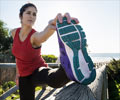Due to the repetitive impact of their feet hitting the ground, Olympic track stars and recreational runners alike can develop stress fractures in bones or soft tissue injuries in joints.

She says the fracture was a direct result of the impact of running.
"There's no doubt it's because of the consistent and constant impact on my legs," Simpson said, in an interview with the National Science Foundation (NSF).
Every time the foot comes down, the ground provides force to stop it. This force passes from the foot, to the knees, up through the hips and even to the back.
Over the years, engineers have come up with a few solutions to the problem of these impacts. Cushioned running shoes and softer track surfaces reduce impact by allowing the foot to stop more slowly.
Good news is that athletes can now help protect their bodies by training on an "anti-gravity treadmill."
Advertisement
"Running on an antigravity treadmill would relive a good deal of the pressure from the joints because you don't have the same forces coming back through the ground into the lower extremities, and back up to the spine," said Justin Laferrier, a physical therapist at the University of Pittsburg.
Advertisement
"You feel like you're running on the moon or something. You just feel like you're bounding," Simpson said.
With the help of this modern engineering, Simpson was able to prepare for the 1500-meter race at the 2011 World Championship, which she won, and head to the Olympics.
Source-ANI











